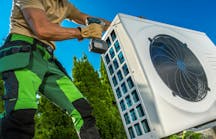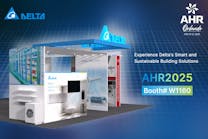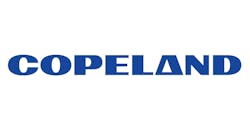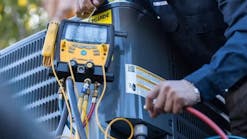By Del Williams
The promise of zoned forced air systems is undeniable. The ability to divide homes into zones to counteract temperature variances in areas with higher concentrations of windows, upper floors where heat rises in the “stack effect,” or to eliminate other hot/cold spots in the home greatly increases comfort for the homeowner – and by extension, satisfaction with the system. Zoning also reduces energy costs significantly when heating/cooling scheduling is used to condition only occupied zones.
However, for some contractors, zoned forced air systems of the past have had a less-than-stellar reputation. Often, the entire system was site-assembled, cobbled together from multiple systems and numerous components. In addition, the “brain” of such systems – the control panel – was often unreliable, providing poor air flow and causing system components like dampers to bind or break.
The result was frequent call-backs for repairs and even total replacement. Because of this, many contractors were reluctant to offer zoned systems to customers, even though it provides significant benefits for both parties.
“Zoning got a bad reputation because the systems were complicated, unreliable, prone to breaking down, and often put together by those without adequate training,” says David Soikkeli, president of DJS Heating and Air Conditioning, an HVAC contractor based in Southern CA.
Fortunately, innovations in design and equipment have simplified the design and installation of zoned forced air systems. Today, factory-integrated packages come complete with “intelligent” control panels, more sophisticated sensors, variable speed blowers, improved dampers and Wi-Fi enabled thermostats. Ready for plug-and-play installation, the new generation of zoning systems has suddenly become much more attractive to HVAC contractors.
“Zoning is the most profitable part of our business today, and if I didn’t offer it, I wouldn’t have a good percentage of my customers,” says Soikkeli. “We don’t have to offer two or three separate systems that must be combined together, so for thousands of dollars less we can give the customer what they want at a price that beats the competition.”
Simplified, Reliable Zoning
With forced air powered by a blower, HVAC zoning control panels essentially direct heating or cooling through a separate duct for each zone, and control the airflow via dampers with thermostats monitoring temperature in each area.
Conventional zoning, however, was hindered by a number of drawbacks. According to Soikkeli, who has installed zoning equipment for over 25 years and has used components from all the major manufacturers, traditional zoning panels were not truly "smart" and did not build-in sensors and safety measures to prevent system errors or even damage to equipment.
“The old way was to put in a bypass damper, and hope you got enough airflow across the coil, but this could cause a freezing or overheating situation,” he says.
Fortunately, improved system design along with advanced technology has greatly simplified the integration, installation, and performance of HVAC zoning systems. Here is an overview of some of the key components and improvements in these new systems.
Zone Control Panels
The “brains” of the system and utilizes advanced computer processors to monitor the thermostats, the HVAC equipment and to open and close the dampers. These panels run off the same kind of power transformer as thermostats and air conditioning equipment.
"Zoning controls like Braeburn’s, for example, have improved dramatically and include built in safety settings that prevent problems,” says Soikkeli. “As the dampers open and close, depending on thermostatic need, the control system watches it, regulates it, makes sure no mistakes occur while the thermostats are making and satisfying calls.”
Installation is simplified with the advanced equipment as well.
“The improvements make zoning systems a lot easier for contractors,” says Soikkeli. “The zone board is expandable to handle many zones, and the controls are simple, basically plug-and-play, which saves us time on installation or adjustments in the field.”
“You don’t need a PhD to set up zoning systems anymore to meet the customer’s requirements,” agrees Steve Stout, President of Kennies Indoor Comfort Specialists, a HVAC contractor based in Northern CA. “They are much simpler to set up, monitor, adjust, program, and use. They can complement high-efficiency variable speed blowers, and offer a lot of flexibility in the staging, bypass and purge times.”
Dampers
Dampers are required for each of the zoned areas. The purpose of the dampers is to open or close and let conditioned air flow where it is needed. The dampers, which are usually wired and powered directly from the zone control panel, can be either power open-power close or spring return with power close.
Most HVAC equipment is designed to operate with air flowing through the entire system. When zoning is applied to a system, and only a few dampers are open, the bypass damper relieves excess air pressure back into the return air.
Previously, zone dampers were notoriously undependable and, according to Soikkeli, contractors were happy if they got even a few years out of them. This is no longer the case.
“We’ve found zone dampers like Braeburn’s to be basically ‘bulletproof,’” says Soikkeli. “In the several years that we’ve installed their dampers and zone equipment, we’ve had zero system breakdowns and no callbacks.”
With such systems, change out is designed to be easy. “If you were ever to have a damper failure, changing the motor can be done with two screws and two wires to get the zoning system fully operational again,” says Soikkeli.
Supply Air Temperature Sensor
To help ensure the system runs at the proper temperature when only a few dampers are open, a supply air temperature sensor may be used by the zone panel to moderate the system output.
“With today’s zoning systems, temperature sensors have gotten very precise so you can limit your duct air temperatures both from the cooling and heating side to prevent damage to your equipment,” says Kennies Indoor Comfort Specialists Stout.
Thermostats
For zoning systems, a thermostat is required in each zoned area to measure and regulate temperature in that zone. The thermostats can be off-the-shelf, single stage, programmable or non-programmable units. They do not need any special connections or settings.
However, with the price of Wi-Fi thermostats dropping, and with virtually everyone owning a smartphone, one of the hottest trends in the industry is toward easy-to-use zoning systems controlled remotely via smartphone.
“Wi-Fi thermostats had been a little expensive, but with the price dropping and the technology getting easier to use, people are willing to buy multiple units,” says Soikkeli.
Some of the most affordable Wi-Fi enabled thermostats are streamlining their operation with intuitive smartphone apps that customers can understand and use at a glance.
“With these new apps, like the Smart Connect App from Braeburn, it’s simple for customers to see which thermostat they are adjusting from their smartphones,” says Soikkeli. “Within minutes of showing customers how to use it, they become experts and say, ‘Oh, this is so easy.’”
While some contractors may be still hesitant to embrace new advanced zoning options, for those that do the benefits are obvious.
“Offering our customers a zoning system and easy to use controls at a price point they can afford can make the difference between getting the job or not,” Soikkeli adds. “As a contractor, that makes a world of difference.”
Braeburn Systems is a Chicago-based manufacturer of thermostats, zoning systems, air filtration, humidification products and accessories.
Del Williams is a technical writer based in Torrance, California.








